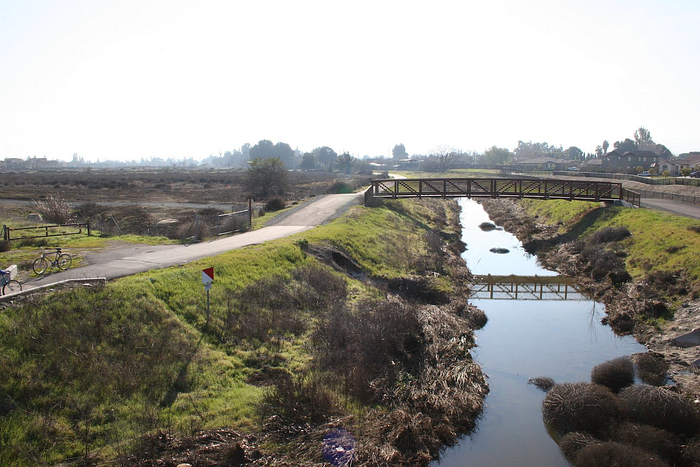Faces of Rivers: Stories of the people transforming how we live alongside rivers.
Mary Helen Nicolini: Aquatic Ecologist, California


Mary Helen Nicolini extends her arms out, outlining Marsh Creek’s meandering path from the highway bridge to where it presumably ends, unseen, at the Bay. As we walk down the trail, she points out an important fact: the restoration of Marsh Creek is not a quick project. It won’t start displaying signs of completion until years down the line. When it is done, the community will enjoy the fruits of a beautifully restored creek, and the native flora and fauna will benefit from thriving, native habitat. The paved trail that parallels the creek will also connect Brentwood to Big Break Shoreline, a six-mile path for the community to explore.
However, as any ecologist knows well, habitat restoration — and particularly creek restoration — takes time. Time from nature, and hard dedication from folks like Mary Helen who are committed to projects that go beyond the ephemeral and invest in the longterm. Luckily, it’s this component that has driven Nicolini throughout her career. Her passion lies in connecting science with people, and using practical solutions that will benefit both the environment and the local community that depends on it.
Nicolini is composed and brilliant; a scientist and aquatic biologist who is precise, cheerful, and passionate. She lights up when she begins chatting about her love for the ocean and science, as she does recalling some of her first memories outdoors. As a child, she was very aware of the changing seasons. How fall’s warmth diminished into winter and how the crops could no longer grow. Through her family, she recounts fishing and spending a significant amount of time in Santa Cruz, at the ocean. Stunningly, at only four and during her first experience in the water, she nearly drowned.
“A wave caught me and tumbled me in,” she says happily. “My parents thought I’d be scared of the ocean for life. I was startled but I actually loved it.”
A 2nd-generation Mexican American, Mary Helen was raised in Merced, the youngest of 7. Her closest sibling still 9 years apart. Her father was a foreman on an almond ranch, and her mother a homemaker who worked during the summers, packing tomatoes. Beyond, her grandparents were migrant farmworkers who moved with the seasons and the crops, from Palm Springs to Santa Rosa. They immigrated to the United States in the 1910s and, through their dedication to the land and environment, laid the foundations for Mary Helen’s lifelong work and approach.

At 59, Mary Helen’s path is familiar to many women of color in STEM, especially considering that she went to college in the late 70s. She recalls being the “only one” studying Marine Biology at UC Santa Cruz, i.e. the only Mexican-American woman in her major, and the offhand comments that sometimes came with it. In one of her most vivid experiences, she remembers being approached at a festival and asked why she wasn’t with her own people.
And yet, while her presence in the programs was sometimes seen as an anomaly, she didn’t think so. “I didn’t grow up seeing myself isolated from nature. I saw that I was a part of it,” says Nicolini. Indeed, her connection to the land from an early age resonates throughout her work, especially in how she favors projects with big scope and longstanding commitment. In other words, projects with positive impacts that might not even come to fruition in her own lifetime.
When you look at Mary Helen’s repertoire of work, it’s clear that her approach is not only holistic — it’s deep-rooted. It seeks to positively affect the lives of people and wildlife through science.
“I didn’t grow up seeing myself isolated from nature. I saw that I was a part of it,”
After graduating from UC Santa Cruz, she went on to study the effects of stormwater runoff on aquatic life for her Master’s. She then looked to become more involved with people and science, and joined the Peace Corps in the Dominican Republic. The goal there was to develop a low tech method of aquaculture that might support the livelihood of local fishermen. Afterward, she worked throughout the Bay Area as an aquatic toxicologist, as a graduate student at UC Berkeley, and most recently worked with Friends of Marsh Creek Watershed, which led her to her current job today.
Presently, Mary Helen works as a contracted Aquatic Ecologist for American Rivers, leading field work to monitor the effectiveness of creek restoration and evaluate changes in water quality. As part of her position, she leads student and volunteer groups — understanding that effective restoration projects must also mean involving the community and the next generation of stewards.
Through the student groups, who are primarily students of color, she is able to teach them about the value of creeks and restoration, while providing hands on experience that could influence their own trajectory later. In the fall, Chinook Salmon run through the creek, so the students are able to directly learn how healthy habitat lead to healthy wildlife. The investment ends up being twofold: both in the creek and in the students who might one day become an aquatic biologist like Mary Helen.
It means the most to know that the work she’s doing will positively affect the local community for years to come. In considering the future, it’s also deeply important that she’s working to impact the environment positively, and leave a lasting impression for her daughter, who’s currently in high school.
After all, that’s where it all comes back. Being able to leave something that’s going to be around for a long time.
American Rivers has worked for a decade alongside Mary Helen Nicolini and other local community partners to restore multiple creeks in Central California’s Marsh Creek watershed. Together, in summer 2020, we will transform approximately 4,000 square feet of what is now a treeless flood control channel into a natural floodplain with native vegetation. American Rivers and partners have obtained additional grants to begin designing future restoration projects downstream, aimed at creating a healthy, continuous riverside corridor for people and wildlife.
Story by Michael A. Estrada (www.brownenvironmentalist.org). This is part of American Rivers’ series Faces of Rivers — stories of the people transforming how we live alongside rivers.
